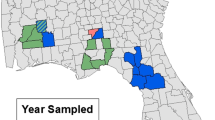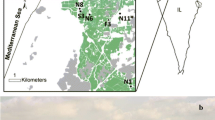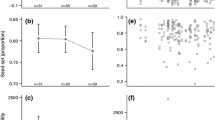Abstract
Land-use intensification is a major cause for the decline in species diversity in human-modified landscapes. The loss of functionally important species can reduce a variety of ecosystem functions, such as pollination and seed dispersal, but the intricate relationships between land-use intensity, biodiversity and ecosystem functioning are still contentious. Along a gradient from forest to intensively used farmland, we quantified bee species richness, visitation rates of bees and pollination success of wild cherry trees (Prunus avium). We analysed the effects of structural habitat diversity at a local scale and of the proportion of suitable habitat around each tree at a landscape scale. We compared these findings with those from previous studies of seed-dispersing birds and mammals in the same model system and along the same land-use gradient. Bee species richness and visitation rates were found to be highest in structurally simple habitats, whereas bird species richness—but not their visitation rates—were highest in structurally complex habitats. Mammal visitation rates were only influenced at the landscape scale. These results show that different functional groups of animals respond idiosyncratically to gradients in habitat and landscape structure. Despite strong effects on bees and birds, pollination success and bird seed removal did not differ along the land-use gradient at both spatial scales. These results suggest that mobile organisms, such as bees and birds, move over long distances in intensively used landscapes and thereby buffer pollination and seed-dispersal interactions. We conclude that measures of species richness and interaction frequencies are not sufficient on their own to understand the ultimate consequences of land-use intensification on ecosystem functioning.



Similar content being viewed by others
References
Aguilar R, Ashworth L, Galetto L, Aizen MA (2006) Plant reproductive susceptibility to habitat fragmentation: review and synthesis through a meta-analysis. Ecol Lett 9:968–980
Aizen MA, Harder LD (2007) Expanding the limits of the pollen limitation concept: effects of pollen quantity and quality. Ecology 88:271–281
Allen-Wardell G, Bernhardt P, Bitner R, Burquez A, Buchmann S, Cane J, Cox PA, Dalton V, Feinsinger P, Ingram M, Inouye D, Jones CE, Kennedy K, Kevan P, Koopowitz H, Medellin R, Medellin-Morales S, Nabhan GP, Pavlik B, Tependino V, Torchio P, Walker S (1998) The potential consequences of pollinator declines on the conservation of biodiversity and stability of food crop yields. Conserv Biol 12:8–17
Baillie JEM, Hilton-Taylor C, Stuart SN (2004) 2004 IUCN red list of threatened species–a global species assessment. IUCN, Gland
Balvanera P, Pfisterer AB, Buchmann N, He JS, Nakashizuka T, Raffaelli D, Schmid B (2006) Quantifying the evidence for biodiversity effects on ecosystem functioning and services. Ecol Lett 9:1146–1156
Bascompte J, Jordano P (2007) Plant-animal mutualistic networks: the architecture of biodiversity. Annu Rev Ecol Evol Syst 38:567–593
BirdLife (2004) Threatened birds of the world 2004. Birdlife International, Cambridge
Bivand R with contributions by Micah Altman, Luc Anselin, Renato Assunção, Olaf Berke, Andrew Bernat, Eric Blankmeyer, Marilia Carvalho, Yongwan Chun, Bjarke Christensen, Carsten Dormann, Stéphane Dray, Rein Halbersma, Elias Krainski, Nicholas Lewin-Koh, Hongfei Li, Jielai Ma, Giovanni Millo, Werner Mueller, Hisaji Ono, Pedro Peres-Neto, Gianfranco Piras, Markus Reder, Michael Tiefelsdorf and Danlin Yu (2010) spdep: Spatial dependence: weighting schemes, statistics and models. R package version 0.5-19. Available at: http://CRAN.R-project.org/package=spdep
Börger L, Franconi N, Ferretti F, Meschi F, De Michele G, Gantz A, Coulson T (2006) An integrated approach to identify spatiotemporal and individual-level determinants of animal home range size. Am Nat 168:471–485
Bommarco R, Biesmeijer JC, Meyer B, Potts SG, Pöyry J, Roberts SPM, Steffan-Dewenter I, Öckinger E (2010) Dispersal capacity and diet breadth modify the response of wild bees to habitat loss. Proc R Soc B 277:2075–2082
Bracken MES, Friberg SE, Gonzalez-Dorantes CA, Williams SL (2008) Functional consequences of realistic biodiversity changes in a marine ecosystem. Proc Natl Acad Sci USA 105:924–928
Breitbach N, Laube I, Steffan-Dewenter I, Böhning-Gaese K (2010) Bird diversity and seed dispersal along a human land-use gradient: high seed removal in structurally simple farmland. Oecologia 162:965–976. doi:10.1007/s00442-009-1547-y
Brennan SP, Schnell GD (2005) Relationship between bird abundances and landscape characteristics: the influence of scale. Environ Monit Assess 105:209–228
Burnham KP, Anderson DR (2002) Model selection and multimodel inference, 2nd edn. Springer, New York
Campos-Arceiz A, Larrinaga AR, Weerasinghe UR, Takatsuki S, Pastorini J, Leimgruber P, Fernando P, Santamaria L (2008) Behavior rather than diet mediates seasonal differences in seed dispersal by Asian elephants. Ecology 89:2684–2691
Carpenter SR (1996) Microcosm experiments have limited relevance for community and ecosystem ecology. Ecology 77:677–680
Chapin FS, Zavaleta ES, Eviner VT, Naylor RL, Vitousek PM, Reynolds HL, Hooper DU, Lavorel S, Sala OE, Hobbie SE, Mack MC, Díaz S (2000) Consequences of changing biodiversity. Nature 405:234–242
Charnov EL (1976) Optimal foraging, the marginal value theorem. Theor Popul Biol 9:129–136
Corlett RT (2007) Pollination or seed dispersal: which should we worry about most? In: Dennis AJ, Schupp EW, Green RJ, Westcott DA (eds) Seed dispersal: theory and its application in a changing world. CABI, Wallingford, pp 523–544
Debinski DM, Holt RD (2000) A survey and overview of habitat fragmentation experiments. Conserv Biol 14:342–355
Dennis AJ, Westcott DA (2007) Estimating dispersal kernels produced by a diverse community of vertebrates. In: Dennis AJ, Schupp EW, Green RJ, Westcott DA (eds) Seed dispersal: theory and its application in a changing world. CABI, Wallingford, pp 201–228
Devictor V, Julliard R, Clavel J, Jiguet F, Lee A, Couvet D (2008) Functional biotic homogenization of bird communities in disturbed landscapes. Global Ecol Biogeogr 17:252–261
DLR-DFD (2009) CORINE Land Cover (CLC2006); Federal Environmental Agency, DLR-DFD 2009. Available at: http://www.corine.dfd.dlr.de/intro_en.html
Farwig N, Bailey D, Bochud E, Herrmann JD, Kindler E, Reusser N, Schuepp C, Schmidt-Entling MH (2009) Isolation from forest reduces pollination, seed predation and insect scavenging in Swiss farmland. Landsc Ecol 24:919–927
Finer MS, Morgan MT (2003) Effects of natural rates of geitonogamy on fruit set in Asclepias speciosa (Apocynaceae): evidence favoring the plant′s dilemma. Am J Bot 90:1746–1750
Foley JA, DeFries R, Asner GP, Barford C, Bonan G, Carpenter SR, Chapin FS, Coe MT, Daily GC, Gibbs HK, Helkowski JH, Holloway T, Howard EA, Kucharik CJ, Monfreda C, Patz JA, Prentice IC, Ramankutty N, Snyder PK (2005) Global consequences of land use. Science 309:570–574
Gathmann A, Tscharntke T (2002) Foraging distances of solitary bees. J Anim Ecol 71:757–764
García D, Chacoff NP (2007) Scale-dependent effects of habitat fragmentation on hawthorn pollination, frugivory and seed predation. Conserv Biol 21:400–411
García D, Zamora R, Amico GC (2010) Birds as suppliers of seed dispersal in temperrate ecosystems: conservation guidelines from real-world landscapes. Conserv Biol 24:1070–1079
Ghazoul J (2005) Pollen and seed dispersal among dispersed plants. Biol Rev 80:413–443
Goulson D (2000) Why do pollinators visit proportionally fewer flowers in large patches? Oikos 91:485–492
Grünewald C, Breitbach N, Böhning-Gaese K (2010) Tree visitation and seed dispersal of wild cherries by terrestrial mammals along a human land-use gradient. Basic Appl Ecol 11:532–541
Hecker U (2001) BLV-Handbuch Bäume und Sträucher: das umfassende Nachschlagewerk; 800 farbige Fotos und Zeichnungen. BLV, Munich
Herrera JM, García D, Morales JM (2011) Matrix effects on plant-frugivore and plant-predator interactions in forest fragments. Landsc Ecol 26:125–135
Hirayama K, Ishida K, Tomaru N (2005) Effects of pollen shortage and self-pollination on seed production of an endangered tree, Magnolia stellata. Ann Bot 95:1009–1015
Hooper DU, Chapin FS, Ewel JJ, Hector A, Inchausti P, Lavorel S, Lawton JH, Lodge DM, Loreau M, Naeem S, Schmid B, Setala H, Symstad AJ, Vandermeer J, Wardle DA (2005) Effects of biodiversity on ecosystem functioning: a consensus of current knowledge. Ecol Monogr 75:3–35
Jordano P, Bascompte J, Olesen JM (2003) Invariant properties in coevolutionary networks of plant–animal interactions. Ecol Lett 6:69–81
Kearns CA, Inouye DW, Waser NM (1998) Endangered mutualisms: the conservation of plant-pollinator interactions. Annu Rev Ecol Syst 29:83–112
Kleijn D, van Langevelde F (2006) Interacting effects of landscape context and habitat quality on flower visiting insects in agricultural landscapes. Basic Appl Ecol 7:201–214
Klein A-M, Steffan-Dewenter I, Tscharntke T (2003a) Fruit set of highland coffee increases with the diversity of pollinating bees. Proc R Soc Lond B 270:955–961
Klein A-M, Steffan-Dewenter I, Tscharntke T (2003b) Pollination of Coffea canephora in relation to local and regional agroforestry management. J Appl Ecol 40:837–845
Klein A-M, Vaissière BE, Cane JH, Steffan-Dewenter I, Cunningham SA, Kremen C, Tscharntke T (2006) Importance of pollinators in changing landscapes for world crops. Proc R Soc Lond B 274:303–313
Knight TM, Steets JA, Vamosi JC, Mazer SJ, Burd M, Campbell DR, Dudash MR, Johnston MO, Mitchell RJ, Ashman TL (2005) Pollen limitation of plant reproduction: pattern and process. Annu Rev Ecol Evol S 36:467–497
Kremen C (2005) Managing ecosystem services: what do we need to know about their ecology? Ecol Lett 8:468–479
Kremen C, Ostfeld RS (2005) A call to ecologists: measuring, analyzing, and managing ecosystem services. Front Ecol Environ 3:540–548
Kremen C, Williams NM, Thorp RW (2002) Crop pollination from native bees at risk from agricultural intensification. Proc Natl Acad Sci USA 99:16812–16816
Kremen C, Williams NM, Aizen MA, Gemmill-Herren B, LeBuhn G, Minckley R, Packer L, Potts SG, Roulston T, Steffan-Dewenter I, Vázquez DP, Winfree R, Adams L, Crone EE, Greenleaf SS, Keitt TH, Klein A-M, Regetz J, Ricketts TH (2007) Pollination and other ecosystem services produced by mobile organisms: a conceptual framework for the effects of land-use change. Ecol Lett 10:299–314
Larsen TH, Williams NM, Kremen C (2005) Extinction order and altered community structure rapidly disrupt ecosystem functioning. Ecol Lett 8:538–547
Lenz J, Fiedler W, Caprano T, Friedrichs W, Gaese BH, Wikelski M, Böhning-Gaese K (2011) Seed-dispersal distributions by trumpeter hornbills in fragmented landscapes. Proc R Soc Lond B 278(1716):2257–2264 doi: 10.1098/rspb.2010.2383
Luck GW, Daily GC (2003) Tropical countryside bird assemblages: richness, composition, and foraging differ by landscape context. Ecol Appl 13:235–247
Lundberg J, Moberg F (2003) Mobile link organisms and ecosystem functioning: implications for ecosystem resilience and management. Ecosystems 6:87–98
MacDonald D, Barrett P (1993) Collins field guide–mammals of Britain & Europe. HarperCollins, London
Marzluff JM, Ewing K (2001) Restoration of fragmented landscapes for the conservation of birds: a general framework and specific recommendations for urbanizing landscapes. Restor Ecol 9:280–292
Mazerolle MJ, Villard M-A (1999) Patch characteristics and landscape context as predictors of species presence and abundance: a review. Ecoscience 6:117–124
Michener CD (2007) The bees of the world, 2nd edn. The Johns Hopkins University Press, Baltimore
Millennium Ecosystem Assessment (2005a) Biodiversity regulation of ecosystem services. In: Hassan R, Scholes R, Ash N (eds) Ecosystems and human well-being: current state and trends, vol 1. Findings of the Condition and Trends Working Group. Island Press, Washington, pp 297–329
Millennium Ecosystem Assessment (2005b) Synthesis: condition and trends in systems and services, trade-offs for human well-being, and implications for the future. In: Hassan R, Scholes R, Ash N (eds) Ecosystems and human well-being: current state and trends, vol 1. Findings of the Condition and Trends Working Group. Island Press, Washington, pp 827–838
Potts SG, Kevan PG, Boone JW (2005) Conservation in pollination: collecting, surveying and monitoring. In: Dafni A, Kevan PG, Husband BC (eds) Practical pollination biology. Enviroquest, Cambridge, pp 401–434
Pyke GH (1979) Optimal foraging in bumblebees: rule of movement between flowers within inflorescences. Anim Behav 27:1167–1181
Quinn GP, Keough MJ (2002) Experimental design and data analysis for biologists. Cambridge University Press, Cambridge
R Development Core Team (2009) R: A language and environment for statistical computing. R foundation for Statistical Computing, Vienna, Austria. Available at: http://www.R-project.org
Ricketts TH, Regetz J, Steffan-Dewenter I, Cunningham SA, Kremen C, Bogdanski A, Gemmill-Herren B, Greenleaf SS, Klein A-M, Mayfield MM, Morandin LA, Ochieng A, Viana BF (2008) Landscape effects on crop pollination services: are there general patterns? Ecol Lett 11:499–515
Santi F (1988) Variabilité génétique inter et intrapopulations chez le merisier (Prunus avium L.). Thèse de Doctorat. INRA, Paris-Grignon
Schleuning M, Templin M, Huamán V, Vadillo GP, Becker T, Durka W, Fischer M, Matthies D (2011) Effects of inbreeding, outbreeding, and supplemental pollen on the reproduction of a hummingbird-pollinated clonal Amazonian herb. Biotropica 43:183–191. doi:10.1111/j.1744-7429.2010.00663.x
Schmid-Egger C, Risch S, Niehuis O (1995) Die Wildbienen und Wespen in Rheinland-Pfalz (Hymenoptera, Aculeata): Verbreitung, Ökologie und Gefährdungssituation. Fauna und Flora in Rheinland-Pfalz, Beiheft 16. Gesellschaft für Naturschutz und Ornithologie Rheinland-Pfalz e.V. (GNOR), Landau
Schueler S, Tusch A, Scholz F (2006) Comparative analysis of the within-population genetic structure in wild cherry (Prunus avium L.) at the self-incompatibility locus and nuclear microsatellites. Mol Ecol 15:3231–3243
Schulze CH, Waltert M, Kessler PJA, Pitopang R, Shahabuddin, Veddeler D, Mühlenberg M, Gradstein SR, Leuschner C, Steffan-Dewenter I, Tscharntke T (2004) Biodiversity indicator groups of tropical land-use systems: comparing plants, birds, and insects. Ecol Appl 15:1321–1333
Sekercioglu CH (2006) Increasing awareness of avian ecological function. Trends Ecol Evol 21:464–471
Steffan-Dewenter I, Münzenberg U, Bürger C, Thies C, Tscharntke T (2002) Scale-dependent effects of landscape context on three pollinator guilds. Ecology 83:1421–1432
Steffan-Dewenter I, Kuhn A (2003) Honeybee foraging in differentially structured landscapes. Proc R Soc Lond B 270:569–575
Steffan-Dewenter I, Potts SG, Packer L (2005) Pollinator diversity and crop pollination services are at risk. Trends Ecol Evol 20:651–653
Tscharntke T, Klein AM, Kruess A, Steffan-Dewenter I, Thies C (2005) Landscape perspectives on agricultural intensification and biodiversity—ecosystem service management. Ecol Lett 8:857–874
Turĉek FJ (1968) The dissemination of Prunus avium L. by birds in forests. Waldhygiene 7:129–132
Tylianakis JM, Rand TA, Kahmen A, Klein A-M, Buchmann N, Perner J, Tscharntke T (2008a) Resource heterogeneity moderates the biodiversity-function relationship in real world ecosystems. PLoS Biol 6:947–956
Tylianakis JM, Didham RK, Bascompte J, Wardle DA (2008b) Global change and species interactions in terrestrial ecosystems. Ecol Lett 11:1351–1363
UNEP (2007) Global Environment Outlook GEO4: environment for development. United Nations Environmental Programme, Nairobi
Wesselingh RA (2007) Pollen limitation meets resource allocation: towards a comprehensive methodology. New Phytol 174:26–34
Westphal C, Steffan-Dewenter I, Tscharntke T (2006) Foraging trip duration of bumblebees in relation to landscape-wide resource availability. Ecol Entomol 31:389–394
Westphal C, Bommarco R, Carre G, Lamborn E, Morison N, Petanidou T, Potts SG, Roberts SPM, Szentgyoergyi H, Tscheulin T, Vaissiere BE, Woyciechowski M, Biesmeijer JC, Kunin WE, Settele J, Steffan-Dewenter I (2008) Measuring bee diversity in different European habitats and biogeographical regions. Ecol Monogr 78:653–671
Westrich P (1989a) Die Wildbienen Baden-Württembergs, Allgemeiner Teil: Lebensräume, Verhalten, Ökologie und Schutz. Ulmer, Stuttgart
Westrich P (1989b) Die Wildbienen Baden-Württembergs, Spezieller Teil: Gattungen und Arten. Ulmer, Stuttgart
Westrich P (1996) Habitat requirements of central European bees and the problems of partial habitats. In: Matheson A, Buchmann SL, O`Toole C, Westrich P, Williams IH (eds) The conservation of bees. Academic press, London, pp 1–16
Williams IH (1996) Aspects of bee diversity and crop pollination in the European Union. In: Matheson A, Buchmann SL, O`Toole C, Westrich P, Williams IH (eds) The conservation of bees. Academic press, London, pp 63–80
Wilson DE, Mittermeier RA (eds) (2009) Handbook of the mammals of the world, vol 1. Carnivores. Lynx Edicions, Barcelona
Winfree R, Griswold T, Kremen C (2007) Effect of human disturbance on bee communities in a forested ecosystem. Conserv Biol 21:213–223
Zamora R, Hódar JA, Matías L, Mendoza I (2010) Positive adjacency effects mediated by seed disperser birds in pine plantations. Ecol Appl 20:1053–1060
Acknowledgements
Studies of seed set were supported by M. Templin, and by S. Eggers, who carefully navigated the mobile access platform into the tree crowns. We thank G. Reder, R. Theunert, C. Westphal and J. Esser for cross-checking difficult bee specimens. We also thank three unknown reviewers for comments on an earlier version of the manuscript. Financial support came from the Deutsche Forschungsgemeinschaft (BO 1221/13-1) and the Ministry for Environment and Forestry Rhineland-Palatinate. All experiments comply with the current laws of Germany.
Author information
Authors and Affiliations
Corresponding author
Additional information
Communicated by Bernhard Schmid.
Electronic supplementary material
Below is the link to the electronic supplementary material.
Rights and permissions
About this article
Cite this article
Breitbach, N., Tillmann, S., Schleuning, M. et al. Influence of habitat complexity and landscape configuration on pollination and seed-dispersal interactions of wild cherry trees. Oecologia 168, 425–437 (2012). https://doi.org/10.1007/s00442-011-2090-1
Received:
Accepted:
Published:
Issue Date:
DOI: https://doi.org/10.1007/s00442-011-2090-1




